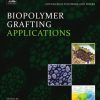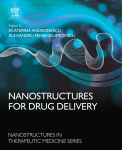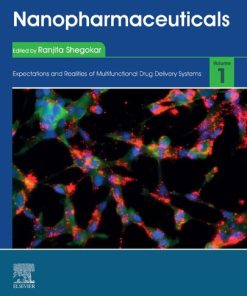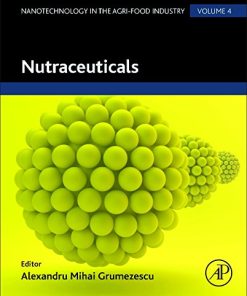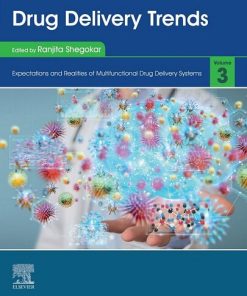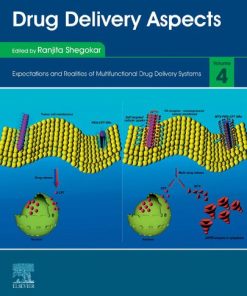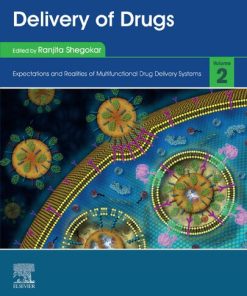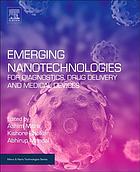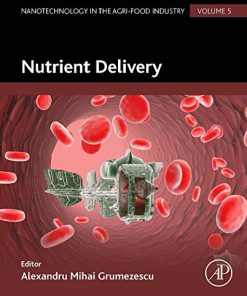Multifunctional Systems for Combined Delivery Biosensing and Diagnostics 1st Edition by Alexander Mihai Grumezescu 0323527264 9780323527262
$50.00 Original price was: $50.00.$25.00Current price is: $25.00.
Multifunctional Systems for Combined Delivery, Biosensing and Diagnostics 1st Edition by Alexander Mihai Grumezescu – Ebook PDF Instant Download/DeliveryISBN: 0323527264, 9780323527262
Full download Multifunctional Systems for Combined Delivery, Biosensing and Diagnostics 1st Edition after payment.
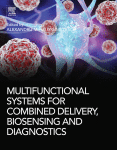
Product details:
ISBN-10 : 0323527264
ISBN-13 : 9780323527262
Author : Alexander Mihai Grumezescu
Multifunctional Systems for Combined Delivery, Biosensing, and Diagnostics explores how multifunctional nanocarriers are being used in combined delivery and diagnostics in contemporary medicine. Particular attention is given to efforts to i) reduce the side effects of therapeutic agents, ii) increase the pharmacological effect, and iii) improve aqueous solubility and chemical stability of different therapeutic agents. The chapters focus on applications of nanostructured materials and nanocarriers, highlighting how these can be used effectively in both diagnosis and delivery.
This applied focus makes the book an important reference source for those wanting to learn more about how specific nanomaterials and nanotechnology systems can help to solve drug delivery and diagnostics problems. This book is a valuable resource for materials scientists, bioengineers, and medical researchers who are looking for an applications-oriented guide on how nanotechnology and nanomaterials can be used effectively throughout the medical treatment process, from diagnosis to treatment.
Multifunctional Systems for Combined Delivery, Biosensing and Diagnostics 1st Table of contents:
Chapter 1: Selective Effects of Azelaic Acid in Nanovesicles on Cell Lines
Abstract
1. Introduction and Historical Background
2. Applications of Anticancer Drug-Loaded Nanovesicles
3. Limitations of Available Therapies: Need of a Novel Therapeutic Strategy
4. Conclusions
Chapter 2: Antimicrobial Photodynamic Therapy (APDT) Action Based on Nanostructured Photosensitizers
Abstract
1. Antimicrobial Photodynamic Therapy (APDT)
2. APDT for Bacterial Eradication
3. Antimicrobial Action of APDT on Healing Processes
4. Conclusions and Future Directions
Chapter 3: Conspectus on Nanotechnology in Oral Cancer Diagnosis and Treatment
Abstract
1. Introduction
2. Oral Cancer Diagnosis: Challenges
3. Oral Cancer Treatment: Challenges
4. Nanotechnology, Nanoparticles, and Nanomedicine
5. Nanoparticles
6. Conclusions
Chapter 4: Lipid-Based Nanocarriers in Cancer Therapy
Abstract
1. Cancer Pathogenesis
2. Cancer Treatments
3. Limitations of Chemotherapy
4. Nanocarriers in the Drug Delivery Process
5. Lipid Nanocarriers
6. Conclusions
Chapter 5: Effect of Polymer-Based Nanoparticles on the Assay of Antimicrobial Drug Delivery Systems
Abstract
1. Introduction
2. Classification of Antibiotics
3. Mechanism of Action of Antibiotics
4. Types of Antibacterial Agents
5. Antibiotic Resistance
6. Intracellular Delivery of Antimicrobial Agents via Polymer-Based Nanocarriers
7. Classification of the Polymer-Based Nanocarriers for Antimicrobial Drug Delivery
8. Analytical Strategies for the Characterization of Drug Delivery Systems
9. Conclusions
Chapter 6: Nanometric Biopolymer Devices for Oral Delivery of Macromolecules with Clinical Significance
Abstract
1. Introduction
2. Mechanisms Behind Oral Transport of Macromolecules
3. Hurdles to Oral Delivery of Macromolecules
4. Enhancement of Oral Absorption of Macromolecules
5. Biopolymer Nanodevices and Delivery of Macromolecules
6. Conclusions
Chapter 7: The Use of Nanotechnology in Modern Pharmacotherapy
Abstract
1. Introduction
2. Polymer-Based Nanoparticles
3. Lipid-Based Nanoparticles
4. Carbon-Based Nanoparticles
5. Nanodispersions
6. Conclusions
Chapter 8: Nanoparticle System for Anticancer Drug Delivery: Targeting to Overcome Multidrug Resistance
Abstract
1. Introduction
2. Cancer and Cell Cycles
3. Molecular Aspects of Multidrug Resistance
4. Nanoparticle Drug Delivery Systems
5. Conclusions
Conflict of Interests
Chapter 9: Application Potential of Engineered Liposomes in Tumor Targeting
Abstract
1. Introduction
2. Engineered Liposomes
3. Biological Targeting
4. Combinatorial Drugs Approach
5. Detachable PEG in Response to Tumor Stimulus
6. Intracellular Delivery
7. Remote-Controlled Payload Release
8. Theranostic Liposomes
9. Recent Advances
10. Conclusions
Chapter 10: Plant-Based Peroral Vaccines
Abstract
1. History and Principles of Plant-Made Vaccines
2. Glycosylation of Antigenic Proteins
3. PapillomatosIs, Vaccines (Gardasil, Cervarix), and our Approaches to the Proposition
4. Future Perspectives
Acknowledgments
Chapter 11: Platelet-Rich Plasma Incorporated Nanostructures for Tissue Engineering Applications
Abstract
1. Introduction
2. Growth Factor and PRP Delivery for Tissue Engineering Applications
3. Chitosan-Based Nanomaterials for the Administration of PRP and Growth Factors
4. Heparin-Containing Nanoparticles for the Entrapment of Growth Factors and PRP
5. PRP and Growth Factor-Containing Electrospun Nanofibers for Regenerative Medicine
6. Carbon Nanotube, Nanographene, and Graphene Oxide-Mediated Delivery of Therapeutics and Growth Factors
7. Other Nanoparticle-Mediated Systems for Growth Factor Delivery
8. Conclusions
Chapter 12: Targeted Nanotherapeutics Based on Cancer Biomarkers
Abstract
1. Introduction to Nanotechnology
2. Nanoparticles for Cancer Therapy
3. Nanotransporters of Drug Delivery
4. Targeted Therapeutics for Cancer Therapy
5. Importance and Issues of Targeted Therapy
6. Nanotherapeutics for Cancer Biomarkers
7. HER2-Targeted Therapeutic Nanostructures
8. EGFR-Based Targeted Therapeutics Nanostructures
9. Folate-Targeted Therapeutics Nanostructures
10. Conclusions and Future Directions
Chapter 13: Therapeutic Nanoparticles for Targeted Delivery of Anticancer Drugs
Abstract
1. Introduction
2. The Critical Impact of Passive and Active Targeting
3. Strategies for Controlled Release
4. Delivery Routes
5. Conclusions and Future Perspectives
Chapter 14: Pulmonary Administration of Biodegradable Drug Nanocarriers for More Efficacious Treatment of Fungal Infections in Lungs: Insights Based on Recent Findings
Abstract
1. Introduction
2. Lung Morphology
3. Lung Fungal Infection
4. Treatment of Lung Fungal Infection
5. Clinical Status to Treat Fungal Infection by Pulmonary Route
6. Importance of Pulmonary Route for Drug Administration
7. Principal Mechanisms of Respiratory Deposition
8. Pulmonary Drug Delivery Devices
9. Pulmonary Formulations to Treat Lung Fungal Infection
10. Why Pulmonary Route?
11. Limitations of Pulmonary Route (If Any)
12. Conclusions
Chapter 15: Alternative Technologies to Improve Solubility and Stability of Poorly Water-Soluble Drugs
Abstract
1. Introduction
2. Biopharmaceutical Classification System
3. Cyclodextrins
4. Solid Dispersions
5. Multicomponent Systems to Enhance Cyclodextrin Complexation
6. Obtaining Methods of Inclusion Complexes, and Solid Dispersion
7. Characterization of Systems
8. Stability Study
9. Conclusions
Chapter 16: Oral Administration of Nanoparticles-Based TB Drugs
Abstract
1. Introduction
2. Gastrointestinal Tract
3. Nanoparticles as Drug Delivery Systems
4. Future Directions and Challenges
5. Conclusions
Acknowledgments
Chapter 17: Recombinant Lactic Acid Bacteria Secreting OxdC as a Novel Therapeutic Tool for the Prevention of Kidney Stone Disease
Abstract
1. Kidney Stones
2. Hyperoxaluria
3. Medical Management of Kidney Stones
4. Probiotics
5. Genetically Modified Lactic Acid Bacteria
6. Risk Assessments of Genetically Modified Lactic Acid Bacteria
7. Conclusions
People also search for Multifunctional Systems for Combined Delivery, Biosensing and Diagnostics 1st:
multifunctional or multi-functional
multipurpose vs multifunctional
multi-carrier system cms
multi-functional or multifunctional
a multi-party system
Tags: Multifunctional Systems, Combined Delivery, Biosensing, Diagnostics, Alexander Mihai Grumezescu
You may also like…
Medicine - Molecular Medicine
Relationships & Lifestyle - Diet & Nutrition
Business & Economics
Engineering
Multifunctional Antennas and Arrays for Wireless Communication Systems (Wiley – IEEE) 1st Edition
Engineering
Emerging nanotechnologies for diagnostics, drug delivery and medical devices 1st edition
Biology and other natural sciences - Plants: Agriculture and Forestry



